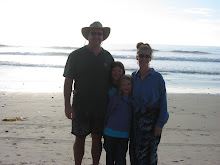




And Thusly the Mojave adventure continues. We spent the next day and a half exploring the dunes in detail. With the weird weather, lots of rain previously and the (apparently) ever present wind, there were very few people on the dunes. In fact, during both climbs of the dunes, we only saw two other people close by, and that only on the main (tallest) dune by the designated parking lot. There was evidence of a couple of people that must have come before we arrived, but for all intents and purposes, it was our own private playground. Distances are deceptive, and looking at the dunes, it is hard to tell how high they are or how far it is to get to the top. In one of the pictures looking down into the valley, we are at the top of one of the tallest dunes, shown from the bottom in one picture. If you look closely at the center of the valley picture, there is a small black/green dot. That is the stand of trees next to our trailer (remember in my last post the picture of the trees and the trailer I said to use as reference?), so we are a ways away. Of course one of the joys of climbing the dunes is running down them and scuffing sand off the ridges. These dunes are ‘singing’ or ‘booming’ dunes. So, when we scuffed enough sand with enough force off of the windward side, they made a cool humming, droning noise. The wind was a gentle breeze, which was refreshing since it started out as a clear day with the sun a beating down. Later in the day, the wind really picked up and in one picture you can see the sand blowing over the edges of the dunes. Interesting fact though; even though the sand was blowing, by definition, sand does not rise above about one meter in the wind, anything above that is dust, which for the most part has long blown away. So even in the wind, very little debris got in our eyes (except Andi since she was the shortest, and even that debris was more from rolling down the dune sides methinks.). Then, after cannon-balling down the dunes, we ended back at the trailer for some rest and well deserved showers (sandy beds are not so much fun). With my Eagles Nest (camping hammock thingy, look it up online) set up in the trees and some chairs set up in the leeward shade of the trailer, lots of relaxation was had by all. During the afternoon, clouds rolled in and provided a beautiful back drop against the dunes to reflect the setting sun. It could have been the isolation, it could have been just what we needed right then, it could have been anything, but I can say, no matter what the reason, the dunes at Mojave were one of if not –the- most magical place we have been to yet. The next post will detail our adventures in the Joshua Trees and the Lava Fields (complete with Indiana Jones style Lava Tube). Stay tuned….


.JPG)















